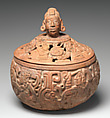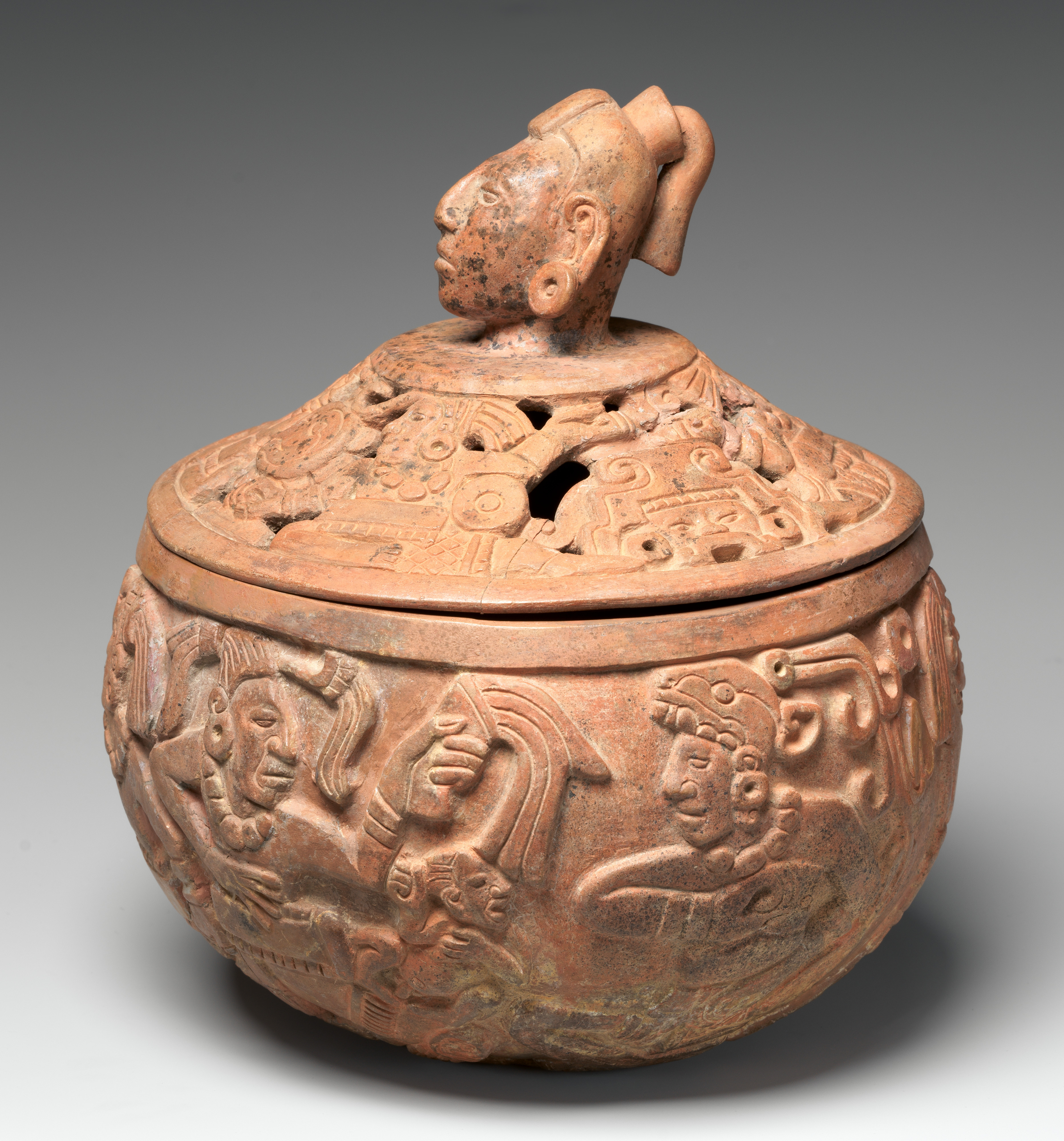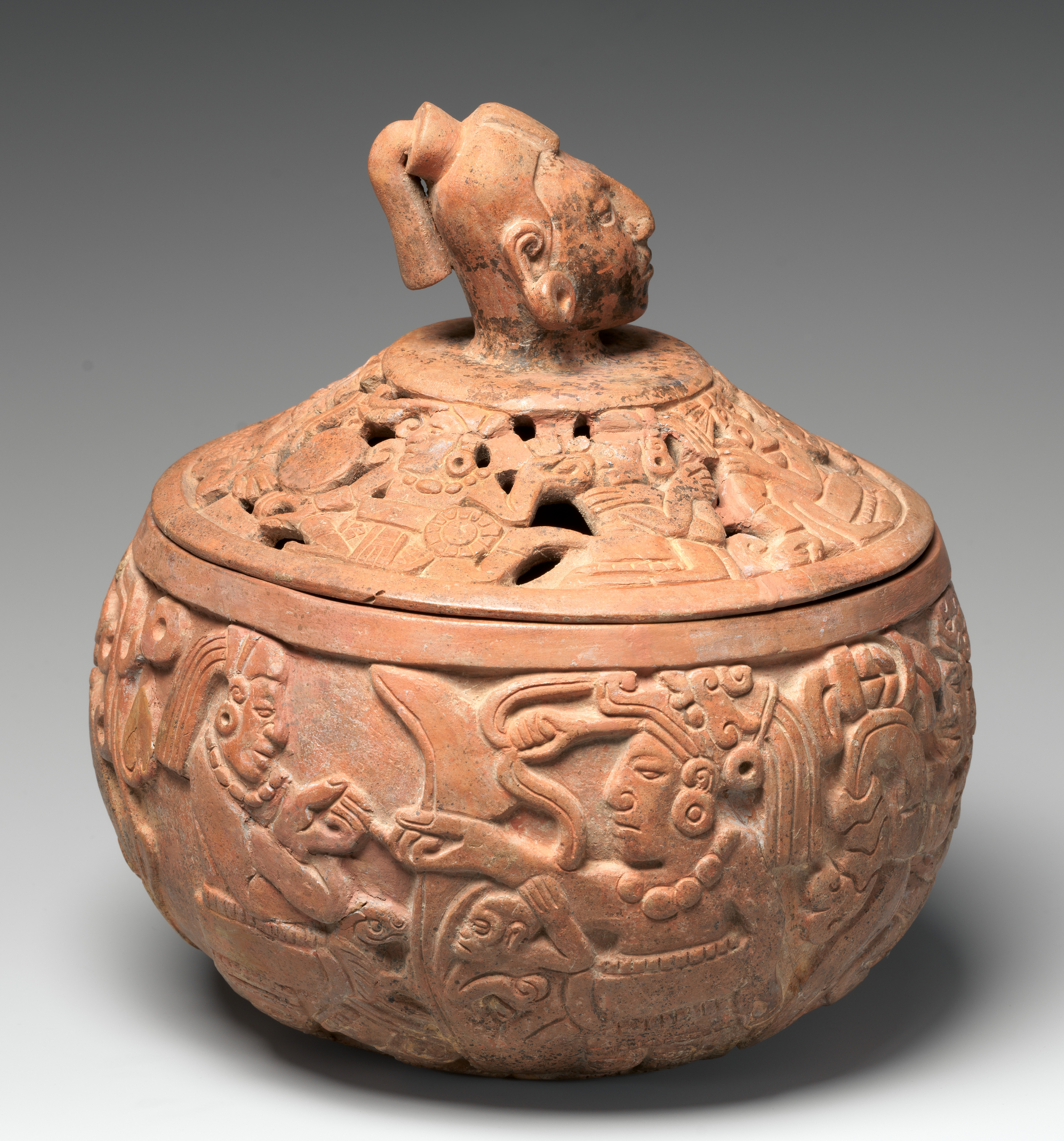Covered Bowl
Not on view
Ancient Mesoamerican ballcourts were perceived as entrances to the underworld, with the rubber ballgame a battle waged at the dawn of creation. In Classic-period Veracruz, decapitation was intricately linked to ballgame rituals. On this fine-paste bowl, the ceramic artist created a stratified view of this cosmogonic myth, with ballplayers in the throes of the game on the surface world represented by the vessel lid, while below them on the body of the bowl, standing attendants face seated lords amid a tropical landscape, symbolizing what could be a royal court or supernatural domain. The vessel knob takes the form of the disembodied head of the Maize God, hair tied back in the style of a ballplayer, emerging three-dimensionally from the relief-carved, lidded bowl.
Five ballplayers adorn the circular lid, consisting of two paired figures centered on a rubber ball, and the fifth individual supporting one of the players from behind. The artist used the conventional Mesoamerican pose denoting the game in action, the players seated and twisted towards the ball, the inner hand directed low, with the opposite arm at a high, outward angle. In each of the pairs, one of the figures has an outstretched leg (as depicted on the Classic Maya Yoke Form Vessel MMA 1970.138a, b). Hair is tied back in ponytails, apart from a long lock of hair protruding from the forehead. In addition to the protective padding worn just below the waist, known as a "yoke" (see MMA 1979.206.423; 1978.412.15; 1979.206.445) the ballplayers wear jade earflares and in some cases jade bead necklaces, suggesting that this is a competition between elites, rather than commoners. The head and body of the fifth supporting ballplayer are twisted, viewing the competition taking place behind him, as though pivoting between the two games.
One ball is plain, the other contains a profiled head, possibly human. By some accounts, the skull of a losing ballplayer was sometimes encased within a rubber ball, heightening the drama of the game. In Classic Veracruz, rubber balls containing human skulls appear in the narrative art of El Tajín; on the mural paintings of Las Higueras; and on similar Río Blanco relief-carved bowls. This theme is not exclusive to the Gulf Coast: severed heads in rubber balls are depicted on a tripod vessel from Escuintla, Guatemala (Von Winning and Gutiérrez Solana 1976, Figure III.1) and most famously on the Great Ballcourt at Chichen Itzá in Yucatan. A stepped design, framing a full-frontal face with handlebar mustache, is placed between the two scenes of facing ballplayers, an anthropomorphized setting that may represent the ballcourt as an animated mountain. A similar lid, with both paired ballplayers and mustachioed face within a stepped enclosure, was found at the site at Ranchito de las Animas, Veracruz and now resides in the Staatliche Ethnological Museum in Berlin, although the sculpted knob and body of the bowl are missing (Von Winning and Gutiérrez Solana 1976, Figure III.2).
Four ballplayers, identified by their yokes, kneepads, and pulled back hair, are portrayed mid-movement on the globular surface of the bowl below. Two elites sit cross-legged between them, one wearing an animal headdress, perched on a jaguar cushion, the other framed by a rattlesnake, recalling an earlier sculpture known as La Venta Monument 19. Lancet-shaped leaves, tropical foliage and vines, a monkey, and a child (or perhaps a dwarf), fill the remaining space, possibly representing a mythical paradise or Flowering Mountain. Art historian Rex Koontz believes that the Flowering Mountain is one of the settings represented on the El Tajín ballcourt panels. In the Tajín narrative, the descent into this fertile paradise follows a ballgame sacrifice. Of the four ballplayers on the bowl, two are undoubtedly supplicants, possibly representing players defeated in the contests depicted on the vessel lid. One waves a torch or feather bundle, while two others offer locks of hair, likely symbolizing defeat. A serpent, mouth open, is poised to bite one of them. His opponent leans in towards him, weight resting on his forward leg.
Relief-carved bowls and fragments have been found archaeologically throughout Veracruz. Hasso Von Winning, who did an extensive study of this ceramic type, referred to it as Río Blanco pottery, after a river in the Mixtequilla region of south-central Veracruz with a high concentration of these fine-paste bowls (as well as other ceramic sculpture, such as those often called "Smiling Figures" (see MMA 1979.206.1211). Von Winning identified key themes on the vessels, including ritual processions, gods and deity impersonators, and ballgame iconography. The present lidded bowl is unique in its depiction of two different, but related scenes, offering a rare narrative sequence generally restricted to painting and relief-carvings on Classic Veracruz architectural features. The knob, which resembles the Classic Maya Maize God, underscores the beliefs, canons of representation, and cranial modification practices that the people of south-central Veracruz shared with their Classic Maya neighbors.
The years 600-1000 A.D. represent the apogee of ceramic sculpture in Veracruz. Río Blanco bowls were mold-made (using two or more molds), then modified by carving when the vessel was at the leather-hard stage. The rich clays of the Mixtequilla required little tempering, giving vessels a porcelain-like consistency. Delicately made, and bearing a masterful composition, this lidded bowl is among the finest examples of Río Blanco pottery to survive to the present day.
Cherra Wyllie, 2022
Further reading
Earley, Caitlin C. "The Mesoamerican Ballgame." In Heilbrunn Timeline of Art History. New York: The Metropolitan Museum of Art, 2000–. http://www.metmuseum.org/toah/hd/mball/hd_mball.htm (June 2017)
Koontz, Rex A. "Iconographic Interaction Between El Tajin and South-Central Veracruz." In Classic Period Currents in Southern and Central Veracruz. Christopher Pool and Phillip J. Arnold, III, eds., pp. 333-338. Washington, DC: Dumbarton Oaks, Harvard University Press, 2008.
Ladrón de Guevara, Sara. "Cerámicas con bajorrelieve" In Sonrisas de piedra y barro, pp. 167-182. Xalapa: Universidad Veracruzana, 2020.
Von Winning, Hasso. "Rituals Depicted on Veracruz Pottery." In Ancient Art of Veracruz, pp. 31-36. Los Angeles: The Ethnic Arts Council of Los Angeles, 1971.
Von Winning, Hasso and Nelly Gutiérrez Solana. La iconografía de la cerámica de Río Blanco, Veracruz. Mexico, DF: Universidad National Autónoma de México, Instituto de Investigaciones Estéticas. 1996.
Wyllie, Cherra. "Continuity and Change in Late Classic Southern Veracruz Art, Religion, and Ritual." In Classic Period Currents in Southern and Central Veracruz. Christopher Pool and Phillip J. Arnold, III, eds., pp. 242-251. Washington, DC: Dumbarton Oaks, Harvard University Press, 2008.
Due to rights restrictions, this image cannot be enlarged, viewed at full screen, or downloaded.
This artwork is meant to be viewed from right to left. Scroll left to view more.




